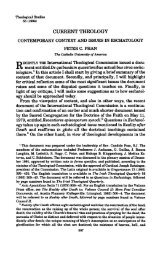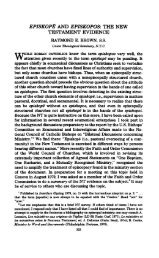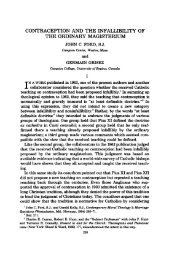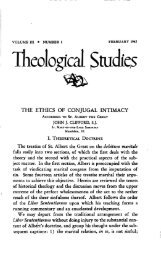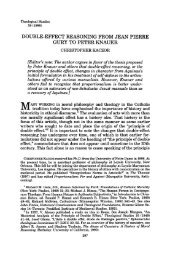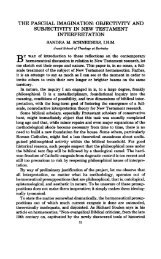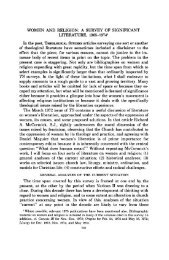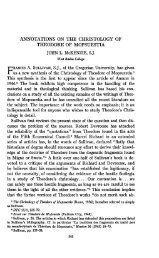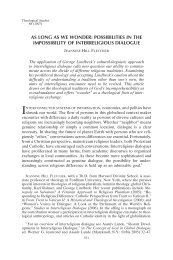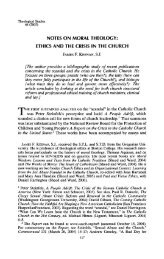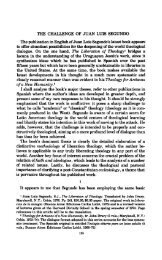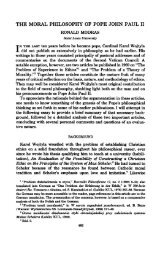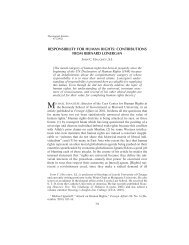SYMBOL, MYTH, AND THE BIBLICAL REVELATION AVERY ...
SYMBOL, MYTH, AND THE BIBLICAL REVELATION AVERY ...
SYMBOL, MYTH, AND THE BIBLICAL REVELATION AVERY ...
You also want an ePaper? Increase the reach of your titles
YUMPU automatically turns print PDFs into web optimized ePapers that Google loves.
<strong>SYMBOL</strong>, <strong>MYTH</strong>, <strong>AND</strong> <strong>THE</strong> <strong>BIBLICAL</strong> <strong>REVELATION</strong> 19<br />
standing of their new faith. For many of these former pagans, the<br />
mystery god simply acquired a new name, Jesus of Nazareth. Thus,<br />
the Christian doctrine of the resurrection of Jesus owed much to the<br />
pagan myths of gods who died and rose; the sacraments of baptism<br />
and the Eucharist were Christian counterparts of what had previously<br />
been practiced in the worship of Attis, Serapis, and other deities.<br />
3) The most recent champion of the mythical view of the New<br />
Testament is Rudolf Bultmann. In a series of writings which go back<br />
to the 1920 , s—and especially in a controversial article published in<br />
1941 43 —he has argued that the New Testament is thoroughly imbued<br />
with myth, notably in the three crucial areas of cosmology, eschatology,<br />
and Christology.<br />
The cosmology, he maintains, is mythical, since the New Testament<br />
writers accept a three-decker view of the universe, in which the earthly<br />
realm is subject to constant incursions from numinous powers who<br />
inhabit the heavens above and the underworld below. The course of<br />
history is largely shaped by the incessant struggle between the spirits<br />
of light and darkness, who seek to wrest it to their own ends. In this<br />
supernatural dualism Bultmann finds traces of Iranian mythology.<br />
As regards eschatology, the early Christians, according to Bultmann,<br />
took over the contemporary Jewish ideas concerning the coming drama<br />
of the end-time. This was to be ushered in by the advent of the Antichrist<br />
and a season of great tribulation. Then the Messiah would<br />
appear in glory, the dead would be recalled to bodily life, the nations<br />
would be judged, and the elect admitted to the heavenly banquet.<br />
In the realm of Christology, Bultmann finds that the figure of Jesus<br />
was heavily overlaid with Jewish mythical expectations concerning<br />
the Messiah, the Son of Man, and the Suffering Servant. Even more<br />
significantly, the Christology of Paul and John, he holds, was influenced<br />
by the Gnostic myth of the primal man (Urmensch), which<br />
seems to have been Iranian in origin but was widely current by that<br />
time in the Near East.<br />
In developing his thesis, Bultmann contends that the New Testament<br />
ideas of the incarnation and virginal conception of Jesus, His<br />
43 "New Testament and Mythology," in Kerygma and Myth (London, 1953) pp. 1-44.<br />
This essay does little more than restate, in more programmatic form, the essential content<br />
of his article in RGG 4 (2nd ed., 1930) 390-94, reprinted without change in the 3rd ed.:<br />
4, 1278-82.



